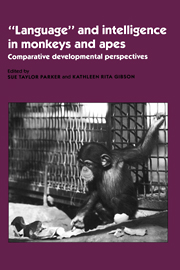Book contents
- Frontmatter
- Contents
- List of contributors
- Foreword
- Preface
- Acknowledgments
- Part I Theoretical frameworks for comparative developmental studies
- Part II Comparative developmental perspectives on cebus intelligence
- 5 The comparative study of cognitive ontogeny in four primate species
- 6 Sensorimotor development in hand-reared and mother-reared tufted capuchins: A systems perspective on the contrasts
- 7 Tool use, imitation, and deception in a captive cebus monkey
- 8 The role of innate motor patterns in ontogenetic and experiential development of intelligent use of sticks in cebus monkeys
- Part III Questions regarding imitation, “language,” and cultural transmission in apes and monkeys
- Part IV Developmental perspectives on social intelligence and communication in great apes
- Part V Development of numerical and classificatory abilities in chimpanzees and other vertebrates
- Part VI Comparative developmental perspectives on ape “language”
- Index
8 - The role of innate motor patterns in ontogenetic and experiential development of intelligent use of sticks in cebus monkeys
Published online by Cambridge University Press: 11 May 2010
- Frontmatter
- Contents
- List of contributors
- Foreword
- Preface
- Acknowledgments
- Part I Theoretical frameworks for comparative developmental studies
- Part II Comparative developmental perspectives on cebus intelligence
- 5 The comparative study of cognitive ontogeny in four primate species
- 6 Sensorimotor development in hand-reared and mother-reared tufted capuchins: A systems perspective on the contrasts
- 7 Tool use, imitation, and deception in a captive cebus monkey
- 8 The role of innate motor patterns in ontogenetic and experiential development of intelligent use of sticks in cebus monkeys
- Part III Questions regarding imitation, “language,” and cultural transmission in apes and monkeys
- Part IV Developmental perspectives on social intelligence and communication in great apes
- Part V Development of numerical and classificatory abilities in chimpanzees and other vertebrates
- Part VI Comparative developmental perspectives on ape “language”
- Index
Summary
In particular cases there is as much difficulty in classifying certain actions as instinctive or rational, as there is in cases where the question lies between instinct and reflex action. And the explanation of this is, as already observed, that instinct passes into reason by imperceptible degrees; so that actions in the main instinctive are very commonly tempered with what Pierre Huber calls “a little dose of judgment or reason,” and vice versa. But here, again, the difficulty which attaches to the classification of particular actions has no reference to the validity of the distinctions between the two classes of actions; these are definite and precise.
– Romanes (1886, p. 16)Given that recent investigators have labeled a variety of behaviors in various birds and mammals as tool use (e.g., Alcock, 1972; Beck, 1980; Hall, 1963; Kortlandt & Kooij, 1962; van Lawick-Goodall, 1970), it is appropriate to establish our definition of “tool use.” We require that to qualify as a tool user, the animal must move a detached object for the purpose of changing the state and/or position of another object or a behavior (Beck, 1980; Parker & Gibson, 1977; van Lawick-Goodall, 1970). Furthermore, we require that to qualify as an intelligent tool user, the animal must understand that the detached object acts as a detached intermediary capable of displacing the goal object, and the animal must understand how to manipulate the object in relation to the physical constraints of the situation, as described later.
Information
- Type
- Chapter
- Information
- 'Language' and Intelligence in Monkeys and ApesComparative Developmental Perspectives, pp. 219 - 244Publisher: Cambridge University PressPrint publication year: 1990
Accessibility standard: Unknown
Why this information is here
This section outlines the accessibility features of this content - including support for screen readers, full keyboard navigation and high-contrast display options. This may not be relevant for you.Accessibility Information
- 7
- Cited by
